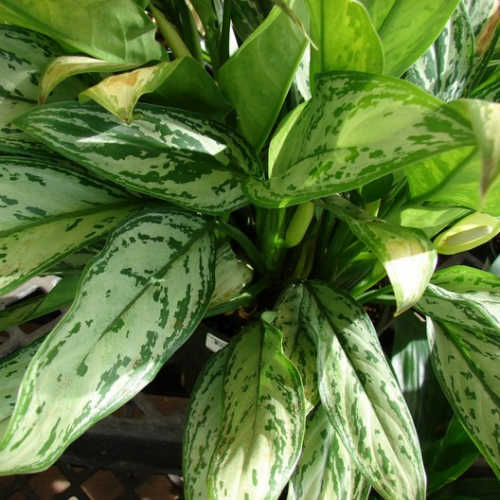Indoor plants Aglaonema

Description
Special Features of Aglaonema
Aglaonema is a genus of evergreen dwarf shrubs and herbs in the arum family Araceae.
It is native to South-East Asia and is found across New Guinea to the north-east India. It comprises 23 species; some sources refer to 50. A few species are domesticated and grown as decorative foliage houseplants:
- Aglaonema nitidum,
- Aglaonema commutatum,
- Aglaonema crispum or Aglaonema roebelenii,
- Aglaonema modestum,
- Aglaonema pictum,
- Aglaonema costatum.
Aglaonema looks very attractive mostly because of its large oblong leaves fastened to a short stem. Their dark green colour gets richer if the plant is exposed to bright sunlight. However, Aglaonema grows equally well in the filtered natural light. Aglaonema blooms in June-August.
Flowers can turn into fruit that are oval berries, often featuring a prominent attractive colour (usually yellow, sometimes red) or just being white.
The Secrets to Successfully Growing Aglaonema
The soil for Aglaonema should be lightweight.
In the summer, keep the soil moist, while in the winter water it moderately. The soil must not dry out. It is better if it is moist to еру touch. Humidity should be high so misting is required, preferably with warm water.
Good drainage promotes good growth.
The best temperatures for plants are 22-25 ° C in the summer and 19-22 ° C in the winter.
Feed the plant during the growing season from March to August once every 2 weeks. Alternate organic and mineral fertilizers. In the autumn and winter, Aglaonema can go without feeding.
Pruning is not necessary but regular repotting is. Repot young plants (younger than 6 years) every year and mature plants every 2 to 3 years. The best time for repotting is early spring in March or April. When repotting, do not firm the topsoil, otherwise it will slow down growth.
Propagate Aglaonema by either dividing the mother plant in the spring or by replanting the new growth coming up at the base of the plant and having 3-4 leaves and good roots, or by air layering, or by seed, which is much less common.
Potential Problems
If leaves develop yellow spots, the plant got sunburnt.
Slow growth and brown edges of the leaves indicate that the water is too cold and/or too hard.
If the leaves are shrivelled and have brown tips, the humidity is too low. If the leaves are shrivelled and have brown tips, the air is not warm enough (or there are drafts). Actually, you should know and always remember that dry cold air is detrimental to the plant and can cause shrivelling and drop of leaves.
Aglaonema's main enemies are red spider mites, mealybugs, aphids, and scale insects.
The sap of Aglaonema commutatum can cause skin irritation. The fruit are also considered toxic.







 334
334







